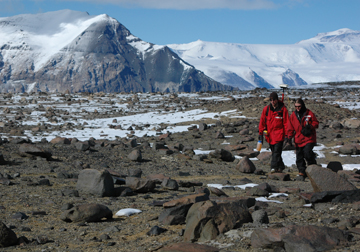Antarctica is warming rapidly, climate scientists report, upsetting fragile ecosystems and threatening the world with a significant rise in sea-levels. With the largely uninhabited and frozen continent melting before humanity’s very eyes, what better time to roll out a new documentary about the coldest, driest and windiest place on Earth.
Billed as a journey to Antarctica for scientific discovery, “Ice People,” a documentary set to air tonight on the Sundance Channel, is really more of an exercise in landscape cinematography.
Two-thirds of the 77-minute film is devoted to capturing some breathtaking panoramas, which was no easy feat. Filmmaker Anne Aghion shot in -60 degree F temperatures to capture some rarely seen images of Antarctica and the people who live and work there. At one point Aghion braved 95-mph winds to document the repair of a windmill on the Ross Sea Archipelago. (They use wind power in Antarctica! — who knew?)
But the result of a film heavy on snow-covered mountains and wind-blown ice and snow is that “Ice People” comes devoid of plot. Lacking a narrator, what descriptive information a viewer gets is from the handful of interviews with the four research scientists who are the principal subjects of the film, and a single scene devoted to documenting operations at McMurdo Station, the largest bastion of humanity on the continent.
When it’s not ogling the landscape, the film followed two field geologists, Drs. Allan Ashworth and Adam Lewis, and two undergraduate students, Kelly Gorz and Andrew Podoll, looking for evidence of a warmer past in ancient Antarctic lakebeds. During the course of the filming, the researchers made a breakthrough discovery of exquisitely preserved moss and leaf fossils, as well as a layer of volcanic ash that allowed the scientists to date the abrupt collapse of a warm Antarctic climate to about 14 million years ago. The discovery of Antarctica’s warm past made headlines around the world last year, but you wouldn’t know that from the film, which glossed over mention of the discovery to make time for more footage of the scientists digging holes in a field of boulders.
In the final 15 minutes, film’s focus shifts dramatically from the Antarctic landscape to the lives of the research scientists. Here, at last, are some one-on-one interviews with the four scientists as well as scenes of their austere living conditions camped out on a frozen lakebed and debating subjects such as the intersection of religion and science (not much intersection, they agreed) and how it feels not to shower for four months (gross).
As awe-inspiring as the cinematography was, had I not been watching “Ice People” for a review, I probably would have given up after the first 20 minutes. The novelty of footage from the exotic Antarctic landscape wore off well before the much more compelling stories of the research scientists ever began to take shape.
But for anyone looking to gaze on one of the last untouched wildernesses on the planet, the footage Aghion recorded is hard to beat.
“Ice People” airs on the Sundance Channel Tuesday night at 10:00 p.m. ET/PT.
Watch the trailer:


